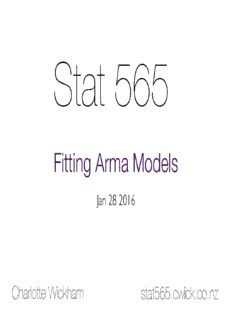
Fitting Arma Models PDF
Preview Fitting Arma Models
Stat 565 Fitting Arma Models Jan 28 2016 Charlotte Wickham stat565.cwick.co.nz HW#2 Be careful smoothing things that aren’t smooth Log transform helped a bit A sudden break at Procedure for ARMA modeling We'll assume the primary goal is getting a forecast. 1. Plot the data. Transform? Outliers? 2. Examine acf and pacf and pick p and q. Or try a few. acf and pacf 3. Fit ARMA(p, 0, q) model to original data. Or fit a arima few. AIC might be useful. 4. Check model diagnostics 5. Forecast (back transform?) Diagnostics If the correct model is fit, then the residuals (our estimates of the white noise process), should be roughly i.i.d Normal variates. Check: Time plot of residuals Autocorrelation (and partial) plot of residuals Normal qq plot Pair data analysis Each pair gets a time series Try to identify and estimate the model. Once you are satisfied, find the other pair(s), with the same series, and see if you agree. Explain your series to a pair with a different one. Time series load(url('http://stat565.cwick.co.nz/data/series-1.rda')) load(url('http://stat565.cwick.co.nz/data/series-2.rda')) load(url('http://stat565.cwick.co.nz/data/series-3.rda')) load(url('http://stat565.cwick.co.nz/data/series-4.rda')) load(url('http://stat565.cwick.co.nz/data/series-5.rda')) load(url('http://stat565.cwick.co.nz/data/series-6.rda')) load(url('http://stat565.cwick.co.nz/data/series-7.rda')) load(url('http://stat565.cwick.co.nz/data/series-8.rda')) Rough code outline 1. Plot, already done: qplot(1:length(x), x, geom = "line") 2. ACF & PACF acf(x) pacf(x) 3. Fit tentative model fit <- arima(x, c(p, 0, q)) 4. Diagnostics res <- residuals(fit) acf(res) pacf(res) qplot(sample = res) 4 2 2 0 x x 0 −2 −2 −4 0 25 50 75 100 0 50 100 150 200 t t 5 4 2 0 x x 0 −5 −2 0 25 50 75 100 0 50 100 150 200 t t 2 2 0 x x 0 −2 −2 0 25 50 75 100 0 100 200 300 t t 5.0 4 2.5 x x 0 0.0 −2.5 −4 −5.0 0 25 50 75 100 0 50 100 150 200 t t Stationarity by differencing HW#2.2 you saw once differencing a process with a linear trend results in a stationary process. In general "d" times differencing a process with a polynomial trend of order d results in a stationary process. Suggests the approach: 1. Difference the data until it is stationary 2. Fit a stationary ARMA model to capture the correlation 3. Work backwards (by summing) to get original series The alternative is to explicitly model the trend and seasonality...more next week HW #2 example x = β + β t + w t 0 1 t a linear trend ∇x = x - x = β + w - w t t t-1 1 t t-1 an MA(1) process with constant mean β 1 x is called ARIMA(0, 1, 1) t
Description: